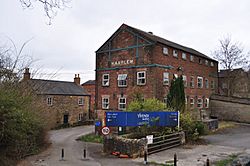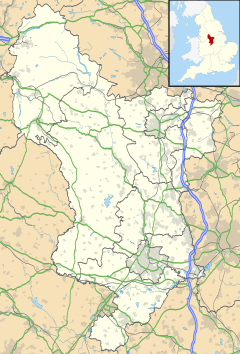Haarlem Mill facts for kids

The mill in 2011
|
|
| Cotton | |
|---|---|
| Spinning watermill | |
| Location | Wirksworth, Derbyshire, England |
| Client | Richard Arkwright |
| Coordinates | 53°04′08″N 1°34′37″W / 53.069°N 1.577°W |
| Construction | |
| Built | 1777 |
| Completed | 1780 |
| Employees | 200 in 1789 |
| Power | |
| Engine maker | Francis Thompson of Ashover |
| Engine type | Supplementary atmospheric |
| Cylinder diameter and throw | 5ft |
| Flywheel diameter | 18ft |
| Water Power | |
| Wheels | Prime mover |
Haarlem Mill was an early cotton mill located on the River Ecclesbourne in Wirksworth, Derbyshire, England. It was built by Richard Arkwright. This mill was very special because it was the first cotton mill in the world to use a steam engine. However, the steam engine wasn't used to power the machines directly. Instead, it helped to make sure the mill had enough water to run its main water wheel.
Contents
Haarlem Mill: A Historic Factory
Haarlem Mill was a groundbreaking factory in the late 1700s. It played an important role in the history of cotton production. The mill was designed to spin cotton into thread. This was a big step forward for the textile industry.
Building the Mill
Richard Arkwright, a famous inventor, leased the land for the mill in 1777. The site already had an older corn mill. Construction of the new brick and stone building finished by June 1780. We know it was working around this time. A young man sadly died trying to climb on the water wheel. This suggests the mill was already running.
The Special Steam Engine
Haarlem Mill is famous for its steam engine. Arkwright first thought about buying an engine from Boulton and Watt. They were a well-known company in Birmingham. But he ended up installing a different type of steam engine. It was probably made by Francis Thompson of Ashover.
This engine was not used to power the cotton machines directly. Its job was to pump water. It helped to keep the mill's water wheel supplied. This was important when the river's water level was low. The engine ran 24 hours a day. It powered two pumps to move the water.
Life at the Mill
By 1789, Haarlem Mill was a busy place. It employed almost 200 people. This shows how important these early factories were. They created many jobs in the local area.
What Happened Next?
Richard Arkwright sold the mill just three years later. Today, the bottom part of the original building still stands. The top three floors have been rebuilt over time.
The building is now an important historic site. It is listed on the Historic England's Heritage at Risk Register. This means it needed special care. In 2018, major repair work was finished. The building has also been converted for new uses.


